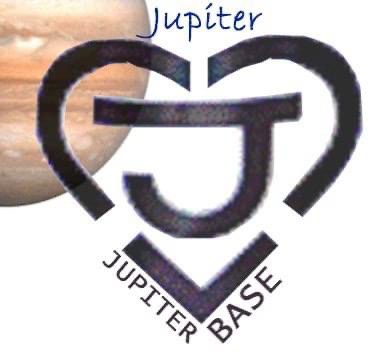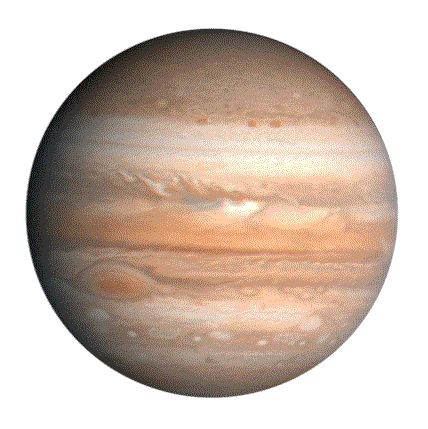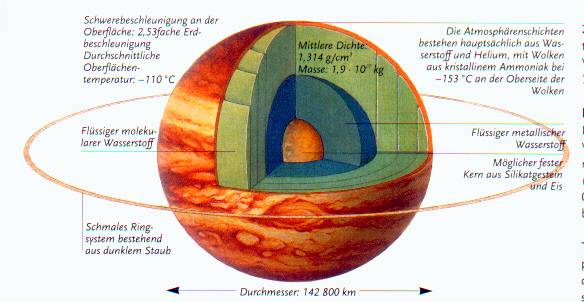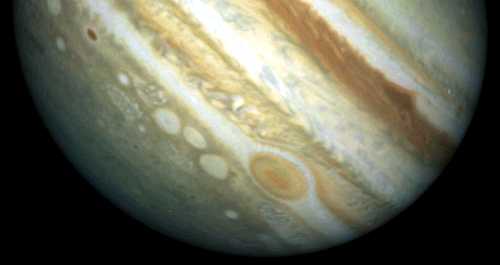


Jupiter is the fifth planet from the Sun and by far the largest. Jupiter is more than twice as massive as all the other planets combined (318 times Earth).
orbit: 778,330,000 km (5.20 AU) from Sun
diameter: 142,984 km (equatorial)
mass: 1.900e27 kg
Jupiter (a.k.a. Jove; Greek Zeus) was the King of the Gods, the ruler of Olympus and the patron of the Roman state. Zeus was the son of Cronus (Saturn).
Jupiter is the fourth brightest object in the sky (after the Sun, the Moon and Venus; at some times Mars is also brighter). It has been known since prehistoric times. Galileo’s discovery, in 1610, of Jupiter’s four large moons Io, Europa, Ganymede and Callisto (now known as the Galilean moons) was the first discovery of a center of motion not apparently centered on the Earth. It was a major point in favor of Copernicus’s heliocentric theory of the motions of the planets; Galileo’s outspoken support of the Copernican theory got him in trouble with the Inquisition.
Jupiter was first visited by Pioneer 10 in 1973 and later by Pioneer 11, Voyager 1, Voyager 2 and Ulysses. The spacecraft Galileo orbited Jupiter for eight years.

The gas planets do not have solid surfaces, their gaseous material simply gets denser with depth (the radii and diameters quoted for the planets are for levels corresponding to a pressure of 1 atmosphere). What we see when looking at these planets is the tops of clouds high in their atmospheres (slightly above the 1 atmosphere level).
Jupiter is about 90% hydrogen and 10% helium (by numbers of atoms, 75/25% by mass) with traces of methane, water, ammonia and “rock”. This is very close to the composition of the primordial Solar Nebula from which the entire solar system was formed. Saturn has a similar composition, but Uranus and Neptune have much less hydrogen and helium.
Our knowledge of the interior of Jupiter (and the other gas planets) is highly indirect and likely to remain so for some time. (The data from Galileo’s atmospheric probe goes down only about 150 km below the cloud tops.)
Jupiter probably has a core of rocky material amounting to something like 10 to 15 Earth-masses.
Above the core lies the main bulk of the planet in the form of liquid metallic hydrogen. This exotic form of the most common of elements is possible only at pressures exceeding 4 million bars, as is the case in the interior of Jupiter (and Saturn). Liquid metallic hydrogen consists of ionized protons and electrons (like the interior of the Sun but at a far lower temperature). At the temperature and pressure of Jupiter’s interior hydrogen is a liquid, not a gas. It is an electrical conductor and the source of Jupiter’s magnetic field. This layer probably also contains some helium and traces of various “ices”.
The outermost layer is composed primarily of ordinary molecular hydrogen and helium which is liquid in the interior and gaseous further out. The atmosphere we see is just the very top of this deep layer. Water, carbon dioxide, methane and other simple molecules are also present in tiny amounts.
Recent experiments have shown that hydrogen does not change phase suddenly. Therefore the interiors of the jovian planets probably have indistinct boundaries between their various interior layers.

Three distinct layers of clouds are believed to exist consisting of ammonia ice, ammonium hydrosulfide and a mixture of ice and water. However, the preliminary results from the Galileo probe show only faint indications of clouds (one instrument seems to have detected the topmost layer while another may have seen the second). But the probe’s entry point (left) was unusual — Earth-based telescopic observations and more recent observations by the Galileo orbiter suggest that the probe entry site may well have been one of the warmest and least cloudy areas on Jupiter at that time.
Data from the Galileo atmospheric probe also indicate that there is much less water than expected. The expectation was that Jupiter’s atmosphere would contain about twice the amount of oxygen (combined with the abundant hydrogen to make water) as the Sun. But it now appears that the actual concentration much less than the Sun’s. Also surprising was the high temperature and density of the uppermost parts of the atmosphere.
 Jupiter and the other gas planets have high velocity winds which are confined in wide bands of latitude. The winds blow in opposite directions in adjacent bands. Slight chemical and temperature differences between these bands are responsible for the colored bands that dominate the planet’s appearance. The light colored bands are called zones; the dark ones belts. The bands have been known for some time on Jupiter, but the complex vortices in the boundary regions between the bands were first seen by Voyager. The data from the Galileo probe indicate that the winds are even faster than expected (more than 400 mph) and extend down into as far as the probe was able to observe; they may extend down thousands of kilometers into the interior. Jupiter’s atmosphere was also found to be quite turbulent. This indicates that Jupiter’s winds are driven in large part by its internal heat rather than from solar input as on Earth.
Jupiter and the other gas planets have high velocity winds which are confined in wide bands of latitude. The winds blow in opposite directions in adjacent bands. Slight chemical and temperature differences between these bands are responsible for the colored bands that dominate the planet’s appearance. The light colored bands are called zones; the dark ones belts. The bands have been known for some time on Jupiter, but the complex vortices in the boundary regions between the bands were first seen by Voyager. The data from the Galileo probe indicate that the winds are even faster than expected (more than 400 mph) and extend down into as far as the probe was able to observe; they may extend down thousands of kilometers into the interior. Jupiter’s atmosphere was also found to be quite turbulent. This indicates that Jupiter’s winds are driven in large part by its internal heat rather than from solar input as on Earth.
The vivid colors seen in Jupiter’s clouds are probably the result of subtle chemical reactions of the trace elements in Jupiter’s atmosphere, perhaps involving sulfur whose compounds take on a wide variety of colors, but the details are unknown.
The colors correlate with the cloud’s altitude: blue lowest, followed by browns and whites, with reds highest. Sometimes we see the lower layers through holes in the upper ones.
 The Great Red Spot (GRS) has been seen by Earthly observers for more than 300 years (its discovery is usually attributed to Cassini, or Robert Hooke in the 17th century). The GRS is an oval about 12,000 by 25,000 km, big enough to hold two Earths. Other smaller but similar spots have been known for decades. Infrared observations and the direction of its rotation indicate that the GRS is a high-pressure region whose cloud tops are significantly higher and colder than the surrounding regions. Similar structures have been seen on Saturn and Neptune. It is not known how such structures can persist for so long.
The Great Red Spot (GRS) has been seen by Earthly observers for more than 300 years (its discovery is usually attributed to Cassini, or Robert Hooke in the 17th century). The GRS is an oval about 12,000 by 25,000 km, big enough to hold two Earths. Other smaller but similar spots have been known for decades. Infrared observations and the direction of its rotation indicate that the GRS is a high-pressure region whose cloud tops are significantly higher and colder than the surrounding regions. Similar structures have been seen on Saturn and Neptune. It is not known how such structures can persist for so long.
Jupiter radiates more energy into space than it receives from the Sun. The interior of Jupiter is hot: the core is probably about 20,000 K. The heat is generated by the Kelvin-Helmholtz mechanism, the slow gravitational compression of the planet. (Jupiter does NOT produce energy by nuclear fusion as in the Sun; it is much too small and hence its interior is too cool to ignite nuclear reactions.) This interior heat probably causes convection deep within Jupiter’s liquid layers and is probably responsible for the complex motions we see in the cloud tops. Saturn and Neptune are similar to Jupiter in this respect, but oddly, Uranus is not.
Jupiter is just about as large in diameter as a gas planet can be. If more material were to be added, it would be compressed by gravity such that the overall radius would increase only slightly. A star can be larger only because of its internal (nuclear) heat source. (But Jupiter would have to be at least 80 times more massive to become a star.)
Jupiter has a huge magnetic field, much stronger than Earth’s. Its magnetosphere extends more than 650 million km (past the orbit of Saturn!). (Note that Jupiter’s magnetosphere is far from spherical — it extends “only” a few million kilometers in the direction toward the Sun.) Jupiter’s moons therefore lie within its magnetosphere, a fact which may partially explain some of the activity on Io. Unfortunately for future space travelers and of real concern to the designers of the Voyager and Galileo spacecraft, the environment near Jupiter contains high levels of energetic particles trapped by Jupiter’s magnetic field. This “radiation” is similar to, but much more intense than, that found within Earth’s Van Allen belts. It would be immediately fatal to an unprotected human being.
The Galileo atmospheric probe discovered a new intense radiation belt between Jupiter’s ring and the uppermost atmospheric layers. This new belt is approximately 10 times as strong as Earth’s Van Allen radiation belts. Surprisingly, this new belt was also found to contain high energy helium ions of unknown origin.
 Jupiter has rings like Saturn’s, but much fainter and smaller (right). They were totally unexpected and were only discovered when two of the Voyager 1 scientists insisted that after traveling 1 billion km it was at least worth a quick look to see if any rings might be present. Everyone else thought that the chance of finding anything was nil, but there they were. It was a major coup. They have since been imaged in the infra-red from ground-based telescopes and by Galileo.
Jupiter has rings like Saturn’s, but much fainter and smaller (right). They were totally unexpected and were only discovered when two of the Voyager 1 scientists insisted that after traveling 1 billion km it was at least worth a quick look to see if any rings might be present. Everyone else thought that the chance of finding anything was nil, but there they were. It was a major coup. They have since been imaged in the infra-red from ground-based telescopes and by Galileo.
Unlike Saturn’s, Jupiter’s rings are dark (albedo about .05). They’re probably composed of very small grains of rocky material. Unlike Saturn’s rings, they seem to contain no ice.
Particles in Jupiter’s rings probably don’t stay there for long (due to atmospheric and magnetic drag). The Galileo spacecraft found clear evidence that the rings are continuously resupplied by dust formed by micrometeor impacts on the four inner moons, which are very energetic because of Jupiter’s large gravitational field. The inner halo ring is broadened by interactions with Jupiter’s magnetic field.
 In July 1994, Comet Shoemaker-Levy 9 collided with Jupiter with spectacular results (left). The effects were clearly visible even with amateur telescopes. The debris from the collision was visible for nearly a year afterward with HST.
In July 1994, Comet Shoemaker-Levy 9 collided with Jupiter with spectacular results (left). The effects were clearly visible even with amateur telescopes. The debris from the collision was visible for nearly a year afterward with HST.
When it is in the nighttime sky, Jupiter is often the brightest “star” in the sky (it is second only to Venus, which is seldom visible in a dark sky). The four Galilean moons are easily visible with binoculars; a few bands and the Great Red Spot can be seen with a small astronomical telescope. There are several Web sites that show the current position of Jupiter (and the other planets) in the sky. More detailed and customized charts can be created with a planetarium program such as Starry Night.
Jupiter’s Satellites

Jupiter has 61 known satellites (as of May 2003): the four large Galilean moons, 34 smaller named ones, plus many more small ones discovered recently but not yet named:
- Jupiter is very gradually slowing down due to the tidal drag produced by the Galilean satellites. Also, the same tidal forces are changing the orbits of the moons, very slowly forcing them farther from Jupiter.
- Io, Europa and Ganymede are locked together in a 1:2:4 orbital resonance and their orbits evolve together. Callisto is almost part of this as well. In a few hundred million years, Callisto will be locked in too, orbiting at exactly twice the period of Ganymede (eight times the period of Io).
- Jupiter’s satellites are named for other figures in the life of Zeus (mostly his lovers).
- Many more small moons have been discovered recently but have not as yet been officially confirmed or named. The most up to date info on them can be found at Scott Sheppard’s site.
Distance Radius Mass Satellite (000 km) (km) (kg) Discoverer Date --------- -------- ------ ------- ---------- ----- Metis 128 20 9.56e16 Synnott 1979 Adrastea 129 10 1.91e16 Jewitt 1979 Amalthea 181 98 7.17e18 Barnard 1892 Thebe 222 50 7.77e17 Synnott 1979 Io 422 1815 8.94e22 Galileo 1610 Europa 671 1569 4.80e22 Galileo 1610 Ganymede 1070 2631 1.48e23 Galileo 1610 Callisto 1883 2400 1.08e23 Galileo 1610 Leda 11094 8 5.68e15 Kowal 1974 Himalia 11480 93 9.56e18 Perrine 1904 Lysithea 11720 18 7.77e16 Nicholson 1938 Elara 11737 38 7.77e17 Perrine 1905 Ananke 21200 15 3.82e16 Nicholson 1951 Crme 22600 20 9.56e16 Nicholson 1938 Pasiphae 23500 25 1.91e17 Melotte 1908 Sinope 23700 18 7.77e16 Nicholson 1914
Values for the smaller moons are approximate. Many more small moons are not listed here.
Jupiter’s Rings
Distance Width Mass Ring (km) (km) (kg) ---- -------- ----- ------ Halo 100000 22800 ? Main 122800 6400 1e13 Gossamer 129200 214200 ?
(distance is from Jupiter’s center to the ring’s inner edge)
Open Issues
- Galileo’s atmospheric probe provides our first direct measurements of Jupiter’s atmosphere, our first real data about the chemistry of a gas planet. The initial data indicate a major new mystery — why is there so little water in Jupiter’s atmosphere? There is a building consensus that the probe encountered an unusually dry area but more details are needed.
- Just how deep into the interior do the zonal winds extend? What mechanism drives them?
- Why is the GRS so persistent? There are actually several theoretical models that seem to work. We need more data to decide between them.
- How can we get more direct information about the interior? Liquid metallic hydrogen has been produced in a lab at Lawrence Livermore National Laboratory but much about its properties is still unknown.
- Why are Jupiter’s rings so dark while Saturn’s are so bright?
Super-Thunderstorms on Jupiter
For 400 years scientists have puzzled over the swirling and turbulent clouds on Jupiter. Now the giant planet’s secret is out.
Based on information provided by Cornell University
Anvil clouds tower more than 30 miles high. Amid the gathering gloom, 100 mph winds whip clouds across the sky. Painfully brilliant lightning flashes punctuate the tumult. Meanwhile, clouds from another giant storm dump several inches of water, every day, over an area more than 600 miles across.
Given the supernatural severity of these storms, and thunderheads three times higher than we see on our planet, we are clearly not on the Earth. Welcome to the super-storms of Jupiter.
The giant planet of the Solar System is as different from the Earth as any planet could be. Jupiter is big enough to fit 1300 Earths inside, and it is made of gas and liquid throughout. Yet some of its storms are remarkably similar – though vaster in scale – to thunderstorms on Earth. Even stranger, the latest results from NASA’s Galileo spacecraft reveal that these storms are powered in a completely different way from terrestrial thunderstorms.
“There is a lot of activity we see on Jupiter that we see on Earth,” says Peter J. Gierasch, professor of astronomy at Cornell University. Along with colleagues from Cornell, the California Institute of Technology and NASA’s Jet Propulsion Laboratory, Gierasch has been studying views of Jupiter taken by Galileo on May 4, 1999. He continues: “We see jet streams, large cyclonic elements, large anti-cyclonic elements and many elements of unpredictability and turbulence.”
Of all the tempest-tossed storms in the Solar System, the astronomers chose to examine an area west of the giant planet’s Great Red Spot, in a region known as the South Equatorial Belt. The images were part of a planned effort to search for local convection, and study its details.

Top: The false colors show how deep the clouds lie in Jupiter’s atmosphere: the highest appear blue, intermediate clouds green and the deepest clouds red.Middle: A lightning strike (blue) is overlaid. It was photographed while the same storm was on the night side of the planet.Bottom: The short lines show wind speeds.
They discovered that some of the storms here closely resemble clusters of thunderstorms found on Earth – mesoscale convective complexes. What is remarkable about the storm complexes on Jupiter, says Gierasch, is that they have the same physics as thunderstorm clusters on Earth, but they are generated by a completely different type of heat source. Generally, thunderstorms on Earth are small individual cells of cumulonimbus clouds, caused by summertime heat from the Sun. A mesoscale convective complex is a cluster of many cells of thunderstorms, of the type that commonly strikes the midwestern United States. These complexes are also formed by intense summertime heat.
The Sun’s heat drives other weather patterns on Earth, of course, such as hurricanes and cyclones. The difference is the source of the system’s ‘fuel’. Hurricanes and cyclones on Earth are fueled by the warm ocean. Mesoscale convective complexes develop because of an instability in the atmosphere. Where it is warm near the Earth’s surface in the summer and cooler aloft, condensation rises and forms many cells of intense thunderclouds over a vast area. These summertime giants can last for hours, even days, and dump unusually large amounts of rain.
 NASAThe violent storms on Jupiter are driven by the immense heat from the core |
On Jupiter, the colossal mesoscale convective complexes also last from 12 hours to several Earth days, producing correspondingly huge deluges of rain over vast areas. The new results show that – contrary to previous belief – these thunderstorm complexes are not fuelled by the Sun’s heat, but instead develop from the intense heat emanating from Jupiter’s core.
The giant planet lies five times further from the Sun than the Earth, so it receives much less solar heat. On the other hand, Jupiter’s core is extremely hot. It still retains heat from the planet’s original formation by collapse and compression of the planet’s huge gaseous bulk. “It is in the process of cooling, and it will likely continue to cool for at least another five billion years,” Gierasch says.
Heat leaks upwards from a reservoir of highly compressed hydrogen in the planet’s center, so this gaseous giant emits nearly 70 percent more heat than it absorbs from the Sun. The source of the stormy turbulence on Jupiter thus seems to be the planet itself.
Mesoscale convective complexes on Earth are riven with lightning, seen dramatically from the space shuttle. What about Jupiter’s giant storm systems? Galileo’s instruments are not able to detect lightning on the planet’s sunlit side. But once the storm crosses into the dark side, astronomers are able to see the lightning and confirm the existence of Jupiter’s mesoscale convective complexes .
 NASAThe Great Red Spot is the most powerful thunderstorm in the Solar System |
These lightning bolts dwarf anything on Earth, according to Andrew. P. Ingersoll of the California Institute of Technology and Blaine Little of ITRES Research, Calgary, Canada. They have measured the Jovian lightning strokes as several times the size of the largest terrestrial bolts.
Jupiter’s storms are not only spectacular. The new Galileo results suggest that the mesoscale convective complexes provide the energy that drives the whole of Jupiter’s powerful weather system. It’s an almost-continuous cycle, Gierasch explains. The storms develop and drop rain; the raindrops evaporate prior to reaching Jupiter’s core heat-source, and rise again as water vapour that convect upwards to start the next round of storms.
In the 400 years since the Italian astronomer Galileo first turned his telescope towards Jupiter, astronomers have puzzled over its spectacular bands and whorls of swirling clouds. Now the giant planet’s secret is out. Its turbulent clouds and ferocious weather systems are fueled by its hidden superhot core, and driven by the greatest thunderstorms in the Solar System.
You can find out more about physics at Cornell University on their webpage.
Want to comment on this article? Send us an e-mail and we’ll publish your most interesting views on our comments page.
This research was published in a letter to the journal Nature under the title Observation of moist convection in Jupiter’s atmosphere. In addition to Gierasch and Ingersoll, the authors were Shawn P. Ewald of Caltech; Donald Banfield, Paul Helfenstein and Amy Simon-Miller of Cornell; Ashwin Vasavada of the University of California, Los Angeles; and Herbert H. Breneman and David A. Senske of JPL.
| There were 3 good arguments that Jesus could have been Black: 1 He called everyone “brother” 2. He liked Gospel 3. He couldn’t get a fair trial. But then there were 3 equally good arguments that Jesus was Jewish: 1. He went into His Father ‘ s business. 2. He lived at home until he was 33. 3. He was sure his Mother was a virgin and his mother was sure he was God. But then there were 3 equally good arguments that Jesus could have been Italian: 1. He talked with his hands. 2. He had wine with every meal. 3. He used olive oil. But then there were 3 equally good arguments that Jesus could have been a Californian: 1. He never cut his hair. 2. He walked around barefoot all the time. 3. He started a new religion. But then there were 3 equally good arguments that Jesus could have been Irish: 1. He never got married. 2. He was always telling stories. 3. He loved green pastures. But the most compelling evidence of all – 3 proofs that Jesus could have been a woman: 1. He fed a crowd at a moment’s notice when there was no food. 2. He kept trying to get a message across to a bunch of men who just didn’t get it. 3. And even when he was dead, He had to get up because there was more work to do. Amen Rebecca Coile |
| Section: JB-1 Members: 2 | ||
| 013 | COMMODORE ADM. MARIA E.G | JUPITER 1981 |
| 004 | CHIEF GENERAL MICHAEL G. | JUPITER – MARS “Eiñahpets” |